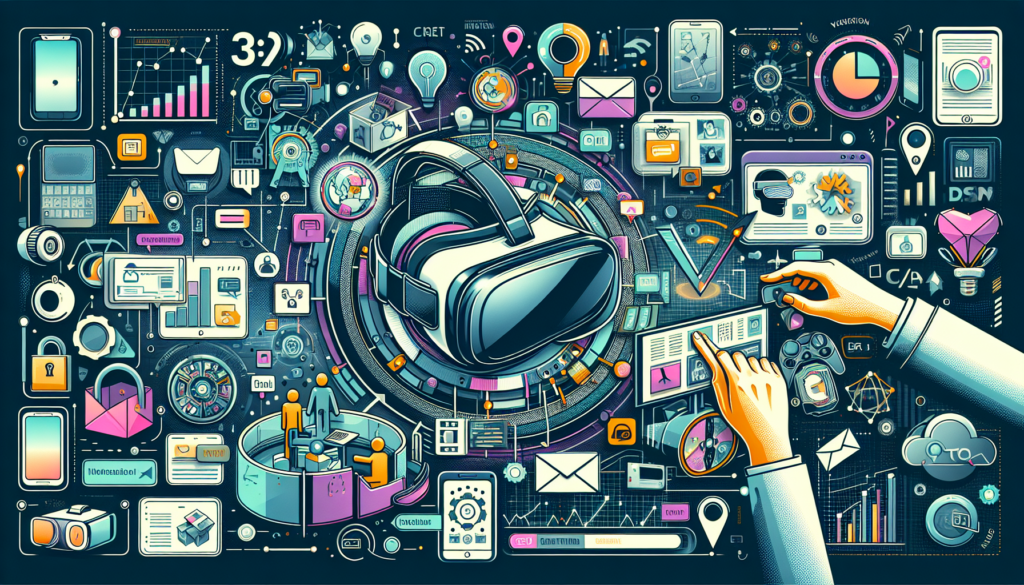In the forefront of digital marketing, virtual reality (VR) stands out as a revolutionary tool with the potential to fundamentally change the way brands interact with their consumers. Through total immersion, VR enables an unprecedented user experience, capable of generating a deep emotional impact and significant brand retention. Thus, this article will explore the most advanced and effective applications of virtual reality within the realm of digital marketing, providing a comprehensive perspective on both underlying theory and contemporary case studies.
Application of Virtual Reality in Digital Marketing
Fundamental Theory and Principles of VR in Marketing
Virtual reality opens up a new range of possibilities based on principles of immersion, interactivity, and complete sensory experience. These principles are the cornerstone upon which marketing can build narratives that transcend the boundaries of physical space and allow users to interact with products or services in an entirely new way.
Immersion is achieved through detailed virtual environments that capture the user’s attention and isolate them from the outside world. Interactivity is accomplished by allowing the user not just to observe but also to manipulate, make decisions, and affect the virtual environment. Finally, the sensory experience is enriched by stimulating not just sight and hearing but potentially other senses, increasing the realism of the experience.
Marketing professionals looking to employ VR must also understand the flow of the user experience, a model that explains how users immerse themselves and engage in the VR experience, moving from being mere spectators to active participants. The user’s transition through this flow is critical to the success of any marketing campaign using VR.
Strategies and Practical Applications
Creating Memorable Brand Experiences
Brands are utilizing virtual reality to create interactive campaigns that leave a lasting memory with consumers. VR product launches, where users can experience a product in a controlled and completely interactive environment, allow for a much richer and engaging presentation than traditional images or videos.
Virtual Tours and Showrooms
Companies in the real estate and automotive sectors, among others, are implementing virtual tours that enable consumers to visit properties and view vehicles without the need to travel. This tactic increases accessibility and convenience for the user, while reducing costs and logistical difficulties for businesses.
Interactive Training and Education
Virtual reality is also being used as a medium to educate consumers about products and practices, such as in skills training or immersion in production processes. This not only informs but also generates appreciation and trust in the brand.
Comparisons and Evolution of Marketing in VR
Virtual reality represents a significant leap over more traditional marketing techniques such as print ads or even two-dimensional digital ads. However, even within the VR spectrum, it’s crucial to note recent innovations like the integration of augmented reality (AR) that complements VR by providing virtual elements over the real world, as well as the evolution towards metaverse platforms where entirely new brand experiences can be created.
Case Studies
Virtual Reality Campaign by Marriott
Marriott Hotels implemented the “VRoom Service” campaign, allowing guests to order VR experiences that transported them to distant exotic destinations from the comfort of their rooms. This innovative use of VR in tourism marketing not only generated publicity but also elevated the stay experience, adding unique value to their services.
Tommy Hilfiger and the Virtual Runway
Tommy Hilfiger made virtual reality glasses available in its stores, through which customers could live the experience of being in the front row at a fashion show. Such an initiative served to combine the physical shopping experience with the appeal of an exclusive virtual runway, increasing customer engagement and brand presence.
Future Trends and Potential Innovations
Looking to the future, virtual reality is expected to evolve to integrate even more with social media and e-commerce platforms, creating a unified platform that can transform digital marketing and the customer experience. Trends point towards greater personalization, where VR experiences could be tailored to the interests and individual behavior of the user, thereby increasing the relevance and effectiveness of targeted marketing.
Conclusion
Digital marketing is on the cusp of a radical transformation driven by virtual reality. Brands that effectively integrate VR into their marketing strategies will not only capture the attention and wonder of their consumers but will also set new standards of immersion and personalization in the user experience. Companies and marketing professionals must stay alert to these emerging trends and continuously adapt to leverage the full potential of VR in this dynamic field.

